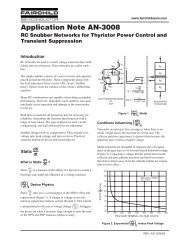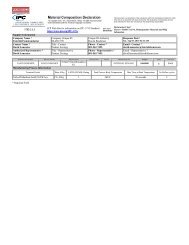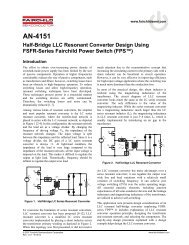AN-9732 - Fairchild Semiconductor
AN-9732 - Fairchild Semiconductor
AN-9732 - Fairchild Semiconductor
Create successful ePaper yourself
Turn your PDF publications into a flip-book with our unique Google optimized e-Paper software.
<strong>AN</strong>-<strong>9732</strong> APPLICATION NOTE<br />
2. Operation Principle of BCM Boost PFC Converter<br />
The most widely used operation modes for the boost<br />
converter are Continuous Conduction Mode (CCM) and<br />
Boundary Conduction Mode (BCM). These two descriptive<br />
names refer to the current flowing through the energy<br />
storage inductor of the boost converter, as depicted in<br />
Figure 2. As the names indicate, the inductor current in<br />
CCM is continuous; while in BCM, the new switching<br />
period is initiated when the inductor current returns to zero,<br />
which is at the boundary of continuous conduction and<br />
discontinuous conduction operations. Even though the BCM<br />
operation has higher RMS current in the inductor and<br />
switching devices, it allows better switching condition for<br />
the MOSFET and the diode. As shown in Figure 2, the<br />
diode reverse recovery is eliminated and a fast-recovery<br />
diode is not needed. The MOSFET is also turned on with<br />
zero current, which reduces the switching loss.<br />
Figure 2. CCM vs. BCM Control<br />
The fundamental idea of BCM PFC is that the inductor<br />
current starts from zero in each switching period, as shown<br />
in Figure 3. When the power transistor of the boost<br />
converter is turned on for a fixed time, the peak inductor<br />
current is proportional to the input voltage. Since the current<br />
waveform is triangular; the average value in each switching<br />
period is proportional to the input voltage. In a sinusoidal<br />
input voltage, the input current of the converter follows the<br />
input voltage waveform with very high accuracy and draws<br />
a sinusoidal input current from the source. This behavior<br />
makes the boost converter in BCM operation an ideal<br />
candidate for power factor correction.<br />
A by-product of BCM is that the boost converter runs with<br />
variable switching frequency that depends primarily on the<br />
selected output voltage, the instantaneous value of the input<br />
voltage, the boost inductor value, and the output power<br />
delivered to the load. The operating frequency changes as<br />
the input current follows the sinusoidal input voltage<br />
waveform, as shown in Figure 3. The lowest frequency<br />
occurs at the peak of sinusoidal line voltage.<br />
Figure 3. Operation Waveforms of BCM PFC<br />
The voltage-second balance equation for the inductor is:<br />
VOUT VIN<br />
( t ) tOFF<br />
V ( t ) t <br />
<br />
(1)<br />
© 2011 <strong>Fairchild</strong> <strong>Semiconductor</strong> Corporation www.fairchildsemi.com<br />
Rev. 1.0.0 • 3/23/11 2<br />
IN<br />
ON<br />
where VIN(t) is the rectified line voltage and VOUT is the<br />
output voltage.<br />
The switching frequency of BCM boost PFC converter is:<br />
f<br />
SW<br />
1<br />
<br />
tON<br />
t<br />
1 V<br />
<br />
t<br />
ON<br />
OFF<br />
OUT<br />
<br />
V<br />
1<br />
t<br />
ON<br />
IN,<br />
PK<br />
V<br />
<br />
V<br />
OUT<br />
sin<br />
OUT<br />
V<br />
V<br />
OUT<br />
IN<br />
( t )<br />
2ft LINE<br />
where VIN,PK is the amplitude of the line voltage and fLINE is<br />
the line frequency.<br />
Figure 4 shows how the MOSFET on time and switching<br />
frequency changes as output power decreases. When the<br />
load decreases, as shown in the right side of Figure 4, the<br />
peak inductor current diminishes with reduced MOSFET on<br />
time and, therefore, the switching frequency increases.<br />
Since this can cause severe switching losses at light-load<br />
condition and too-high switching frequency operation may<br />
occur at startup, the maximum switching frequency of<br />
FL7930 is limited to 300KHz.<br />
(2)







